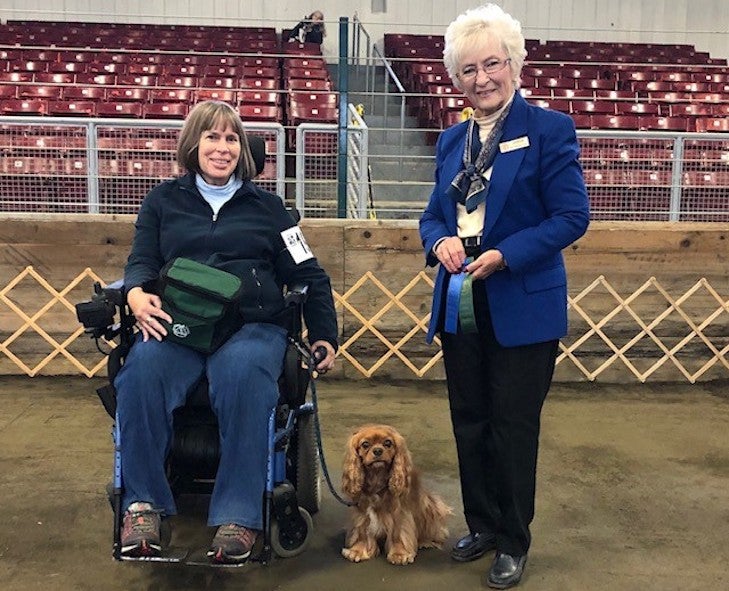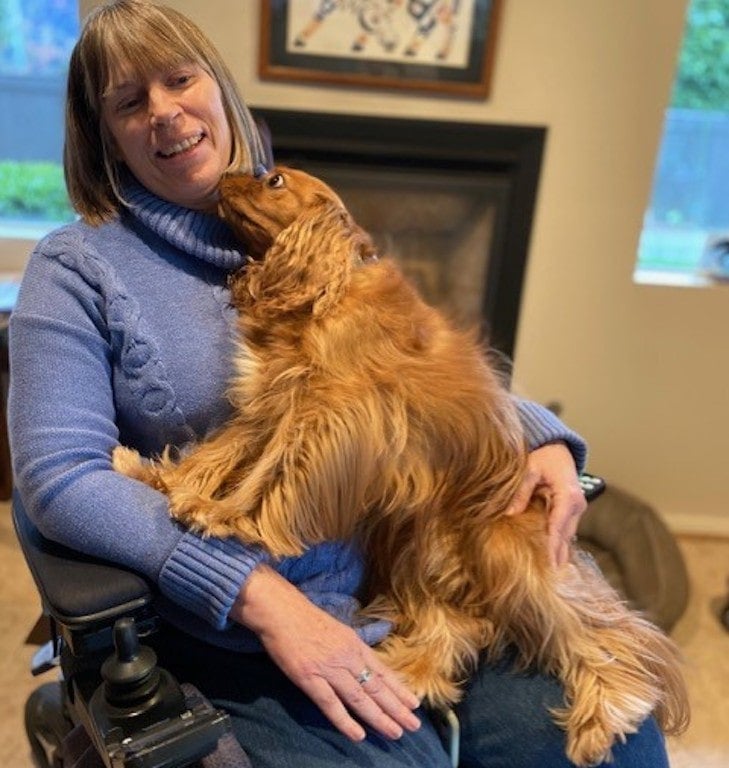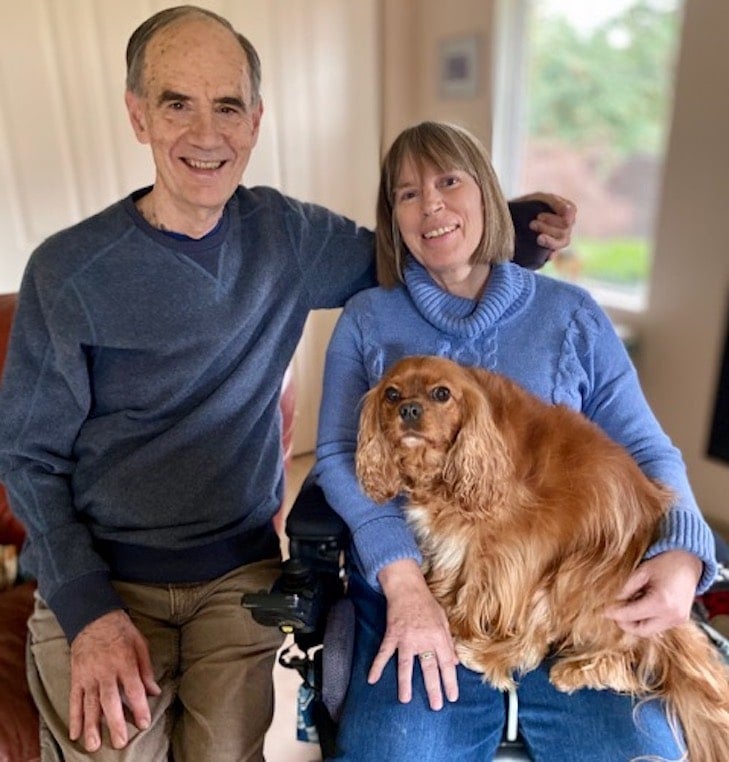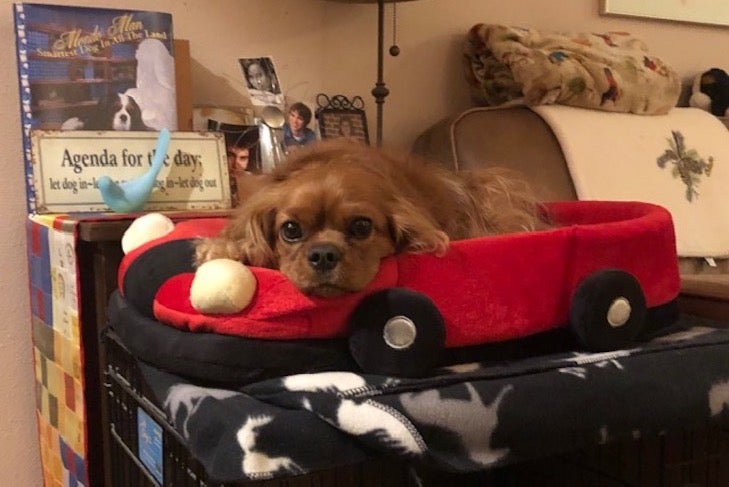
For Anne Brastow, Obedience and Agility are all about daunting physical and psychological challenges with each step in the ring. But, you’re probably asking yourself, isn’t that the case for many?
That may be true, but when the Bellevue, Washington, owner-handler competes in both AKC dog sports, she’s doing so from a powered wheelchair. Consequently, her 7-year-old, multi-titled Cavalier King Charles Spaniel Radar must be considerably more attentive than your average four-legged teammate.
“He needs to be my willing partner and learn to figure out what I want when I can’t be clear,” Brastow emphasizes. “It takes a lot of time to break things down so he can grasp what I want, while still keeping it a game. In the process, I have to rely on verbal commands, which is difficult.”
Discovering Dog Sports
Agility course complexity has increased as Brastow’s physical abilities have decreased. Therefore, she’s required resourceful and resilient training techniques in order to maintain a pathway of progress.
Brastow has a progressive form of muscular dystrophy called limb-girdle type 2A/R1. Because of the effects of the disease, she experiences muscle weakness and is unable to walk, lift her arms, or rotate her shoulders. In 2008, however, the idea of dog sports began to intrigue her, and she decided to give agility a shot. Soon enough, she was moving on to Obedience and AKC Rally® with an energetic Cavalier puppy named Rocky.
“I just wanted to have fun and keep Rocky busy,” she recalls. “I didn’t want to get involved in any sort of competition because I thought that would remove the fun.”

After a few agility lessons, she began to practice at home. Pretty soon, the entertaining and engaging Rocky was weaving and jumping all over the yard. Still in the mindset of keeping it fun, Brastow searched for a nearby class. The instructor was confident she could successfully participate.
“I didn’t know about front crosses, body positioning, or hand signals,” says Brastow. “I just said ‘jump’ and he jumped, and ‘weave’ and he weaved. But I didn’t know what I was getting into.”
Adjusting to Agility Obstacles
Training isn’t routine since most classes and formal videos teach in a manner that she’s unable to execute. Not easily discouraged, Brastow constantly improvises management techniques for Radar. For instance, training “stand for exam” has proven especially difficult for the owner-handler, who is unable to assist Radar with her hands.
“Teaching him to understand a ‘stand’ took me years,” she explains. “Getting him to stay and not wiggle his body while I move behind him was also challenging. I’m proud to say that we can do this and sometimes in the ring.”
Brastow doesn’t travel far from the Greater Seattle area for competitions. She estimates she competes in about 12 two-day agility trials and three obedience counterparts a year. The most important factor when considering an agility trial is the venue’s surface. In an ideal world, Brastow and Radar need a smooth, firm layout. If the footing is too soft, her chair’s wheels become bogged down and she is unable to make needed quick turns. Turf is ideal, but facilities with such surfaces can be hard to come by.
Ring gates present another accessibility challenge. In certain venues, moving in and out of the rings using her wheelchair has proven increasingly difficult for Brastow and the 18-pound Radar. Surface is key in the obedience ring, too, as she has found herself tangled in mats when doing an about-turn. She also seeks facilities with adequate parking for her wheelchair van.
“I need a spot wide enough for the ramp to deploy,” she explains. “And one that won’t allow someone to block that space while I’m competing so I can’t get back into my van. I stay away from ring layouts where the entrance can get congested. I’m always able to get into the ring, but maneuvering through a crowd with my dog can be an added stress for both of us.”
A Family Affair
One key to helping “Team Brastow” succeed is Anne’s husband, Bill, who drives her to weekly midweek training classes, helps walk Radar, assists in classes, guides him to his crate, fills the water bowl and gets the training treats. In agility class, he sets up the bars as well.

For competition days, Bill assists Anne with early morning departure tasks like getting Radar fed, packing lunches, snacks, dog treats, water, and gear. Bill also handles dog walking (and poop-scooping) as Anne gets cold easily and wheelchairs do not function well when dampness mixes with electronics.
“Above all, he encourages me, enjoys our successes, and is always there when challenges arise,” she says. “I am incredibly blessed. He’s my saint.”
Naturally, not much is simple for Team Brastow when it comes to dog sports. For instance, Anne utilizes different wheelchairs for agility, obedience, and home use. Also, while needing an unflinching focus on the challenge at hand when in the ring, the 58-year-old competitor must always be alert to those around her.
“Sometimes it’s just something I see out of the corner of my eye,” she explains. “Other times I spot dogs crouch down and stare at my wheels. In one instance, I was approached by a handler asking me to let his dog come by and sniff my chair. If I see someone with a puppy, I attempt to let it get acquainted with my chair. Handlers are good about allowing their pup to see my chair move in a controlled situation. This helps prevent the dog from becoming startled and forcing us to spend years trying to undo that initial response.”
Breaking Down Barriers
So, why Cavaliers? Brastow loves to talk about what makes the Toy Group breed so special.
“I love their sporty nature,” she says. “They are wonderful companions that follow me around the house. They like to be close, sit on my lap, or stare into my eyes—especially when food is involved. Mine don’t walk calmly alongside but zig-zag all over the place with their tails constantly wagging. They are very alert, whether it comes to birds, squirrels, bunnies, or people. I love their long ears and flag of a tail. There is nothing prettier than to see my dogs in the yard with the wind blowing their fur while they are surveying their kingdom.”

Beyond helping to realize what she and Radar are capable of as athletes, obedience and agility competitions have enabled Brastow to build an ever-expanding network of friends.
“Without the dog sports, I would have a very sheltered life,” she says. “They have become my extended family. In the process, Radar has pushed me physically and psychologically to improve my well-being. And, for that, I will always be grateful. It’s truly been a win-win.”

